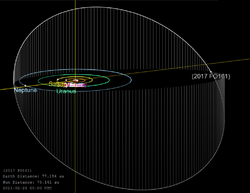Astronomy:2017 FO161
From HandWiki
Short description: Asteroid
 Orbital diagram of 2017 FO161 | |
| Discovery[1][2] | |
|---|---|
| Discovered by | CTIO |
| Discovery site | CTIO |
| Discovery date | 23 March 2017 |
| Designations | |
| 2017 FO161 | |
| Minor planet category | TNO[3] · SDO[4] distant[1] |
| Orbital characteristics[3] | |
| Epoch 31 May 2020 (JD 2459000.5) | |
| Uncertainty parameter 4 | |
| Observation arc | 11.11 yr (~4,000 d) |
| Earliest precovery date | 19 March 2012[5] |
| |{{{apsis}}}|helion}} | 85.459 AU |
| |{{{apsis}}}|helion}} | 34.069 AU |
| 59.764 AU | |
| Eccentricity | 0.42994 |
| Orbital period | 462.03 yr (168,756 d) |
| Mean anomaly | 240.958° |
| Mean motion | 0° 0m 7.68s / day |
| Inclination | 54.350° |
| Longitude of ascending node | 164.985° |
| 151.017° | |
| Physical characteristics | |
| Mean diameter | 612 km (est. at 0.09)[4] |
| Geometric albedo | 0.09 (est.)[4] |
| Absolute magnitude (H) | 4.3[3] |
2017 FO161 is a large trans-Neptunian object from the scattered disc located in the outermost region of the Solar System. It is estimated to measure approximately 600 kilometers (370 mi) in diameter and currently orbits at a distance of about 78.5 AU from the Sun.[1][3][4] The object was first observed by American astronomers Chad Trujillo and Scott Sheppard using the 4-meter Víctor M. Blanco Telescope at the Cerro Tololo Inter-American Observatory in Chile on 23 March 2017.[2] Precovery observations were made by the Pan-STARRS-1 survey at Haleakalā Observatory and by the Dark Energy Survey with DECam, dating back as far as March 2012 and January 2016, respectively.[1]
See also
- List of possible dwarf planets
- List of Solar System objects most distant from the Sun
- 2017 FP161
References
- ↑ 1.0 1.1 1.2 1.3 "2017 FO161". Minor Planet Center. https://www.minorplanetcenter.net/db_search/show_object?object_id=2017+FO161. Retrieved 6 March 2019.
- ↑ 2.0 2.1 Trujillo, C.; Sheppard, S. S. (April 2018). "2017 FO161". Minor Planet Electronic Circulars 2018-G10. ISSN 1523-6714. Bibcode: 2018MPEC....G...10T. https://www.minorplanetcenter.net/mpec/K18/K18G10.html.
- ↑ 3.0 3.1 3.2 3.3 "JPL Small-Body Database Browser: (2017 FO161)". Jet Propulsion Laboratory. https://ssd.jpl.nasa.gov/sbdb.cgi?sstr=3802117. Retrieved 6 March 2019.
- ↑ 4.0 4.1 4.2 4.3 Johnston, Wm. Robert (18 August 2020). "List of Known Trans-Neptunian Objects". Johnston's Archive. http://www.johnstonsarchive.net/astro/tnoslist.html. Retrieved 3 March 2021.
- ↑ https://www.minorplanetcenter.net/db_search/show_object?object_id=2017+FO161
External links
- The Kuiper Belt Electronic Newsletter, April 2018, Joel Parker, SWRI
- List Of Centaurs and Scattered-Disk Objects, Minor Planet Center
- 2017 FO161 at AstDyS-2, Asteroids—Dynamic Site
- 2017 FO161 at the JPL Small-Body Database
 |

